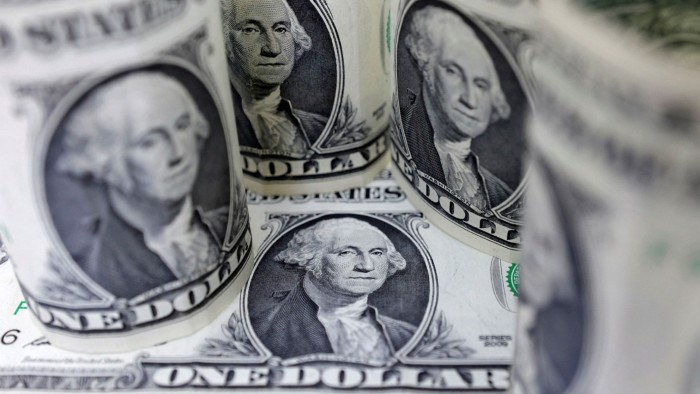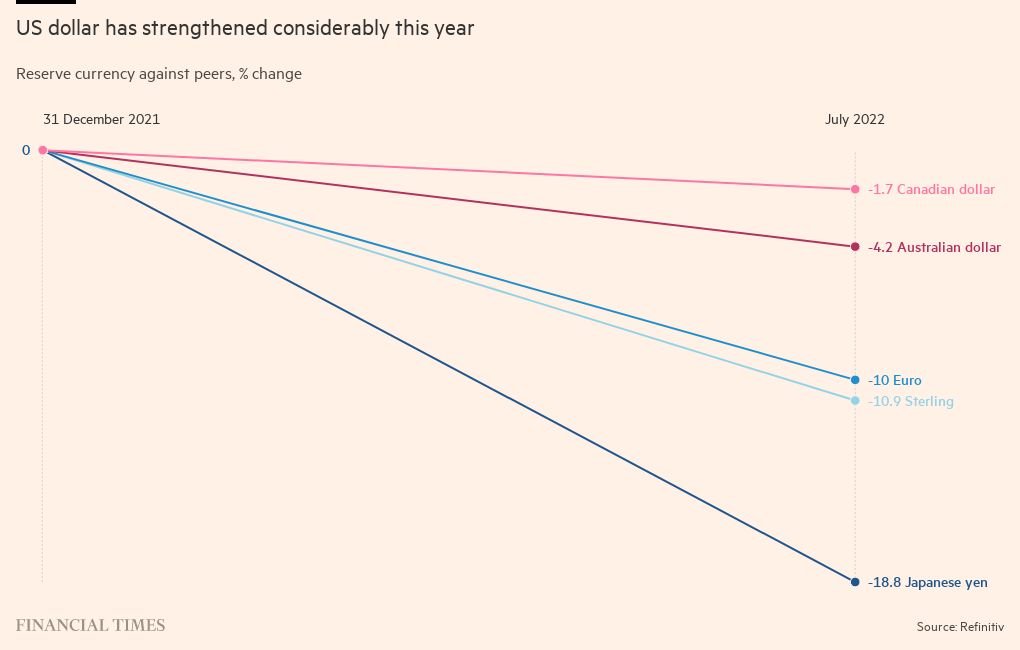Is the dollar about to take a turn?

Roula Khalaf, Editor of the FT, selects her favourite stories in this weekly newsletter.
The writer is professor of economics and political science at the University of California, Berkeley
The dollar has had a spectacular run, having risen more than 10 per cent against other major currencies since the start of the year.
Actually, not a few governments and central banks would prefer the adjective “disastrous” to “spectacular”. For developing countries, from Sri Lanka to Argentina, the greenback’s rise has made servicing dollar-denominated debts, already a difficult task, essentially impossible.
For emerging markets such as Chile that are not heavily saddled with debts, it has raised inflation by increasing the local-currency equivalent of dollar-denominated food and energy prices. Inflation and the fall in its currency have forced the Bank of Chile to raise its policy interest rate an extraordinary nine times in the past year and now to deploy its reserves in support of the peso exchange rate.
For the European Central Bank, there has been the embarrassment of seeing the euro fall to parity against the dollar. For the Bank of Japan, there is the fact that the yen has been the worst-performing advanced-country currency on the planet this year.
Why the dollar has strengthened is no mystery. Seeing both high inflation and strong growth, the Federal Reserve has been raising interest rates faster than other big central banks, drawing capital flows toward the US.
The ECB, despite having cautiously kicked off its tightening cycle last week, is moving noticeably more slowly. The curtailment of Russian energy supplies is already weighing on European growth, and higher interest rates would send a fragile Italian debt market reeling, given the ill-timed rise in political uncertainty in that country.
The Bank of Japan, meanwhile, has no immediate reason for thinking that the country’s “lowflation” problem has been solved, and is not inclined to abandon its “yield-control” policy to keep interest rates down. Neither the BoJ nor the ECB will be matching the Fed by raising policy rates in 75 or 100 basis-point increments.
Some will invoke the rise of geopolitical risk from the endless Russia-Ukraine war and the dollar’s status as a haven. There may be yet more haven flows with tensions around the Taiwan Strait and Iran. But at the end of the day, recent currency movements have been driven by central banks. The same will be true going forward.
It is not news, admittedly, that having fallen behind the curve, the Fed is now scrambling to catch up. Thus, the expectation of further rate rises from Fed chair Jay Powell and others is already in the market. There is no reason why those additional policy rate increases should move the dollar any higher, in other words.
But two additional developments complicate the exchange-market outlook. First, other central banks — the ECB and BoJ notwithstanding — are showing an increasing willingness to match the Fed in raising rates to address their own spiralling inflation problems. These already include the central banks of Canada, the Philippines, Singapore, New Zealand and South Korea, among others. The list is growing.
These countries’ finances are sufficiently strong to withstand interest rate rises, and inflation is a matter of common concern. Their central banks are therefore at least keeping pace with the Fed. The dollar has consequently shown less strength against a broad basket including the currencies of these countries. The same is apt to be true in the weeks and months ahead.
Second, and more ominously, there is recession risk in the US. Current dollar pricing is predicated, to repeat, on the expectation that the Fed will continue to raise rates. That expectation is based in turn on the hopeful assumption that the US economy will continue to expand.
If the Fed-engineered slowdown spreads from the housing market to retail sales and business investment, the combined effect will drag down not just US spending but also inflation.
The idea that, in these recessionary circumstances, inflation will remain in the high single digits and the Fed will therefore be forced to continue its tightening cycle, is quite daft.
As Fed chair, Paul Volcker kept raising rates in the face of a recession — and the dollar kept soaring — because inflation remained stubbornly high for several years. There is little sign of similar inflation inertia today.
So if the economy and inflation weaken, the Fed will pause, and the dollar will reverse direction. This is no longer a risk that can be dismissed.
Letter in response to this article:
China isn’t to blame for debt woes of BRI nations / From Khairy Tourk, Professor of Economics, Stuart School of Business, Illinois Institute of Technology, Chicago, IL, US

Comments